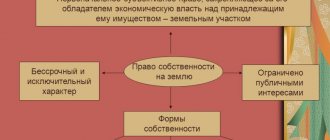General information about encumbrances
The legislation does not have a clear answer to what an encumbrance on a land plot is. This concept was contained in the already abolished Art. 1 . It followed from the law that encumbrances should be considered conditions and prohibitions that limit the right holder in the exercise of ownership and other proprietary rights to real estate: disposal, possession, use.
Although the normative act has lost force, the definition established by it is still relevant. Its analysis allows us to understand the essence of the phenomenon and characteristics:
- An encumbrance is a restriction that restricts certain rights of the land owner.
- It is intended to protect the subjective rights of third parties in whose favor it is established: creditor, tenant, mortgagee.
- The encumbrance is not associated with the deprivation of the owner of his rights, since, as a rule, it is temporary.
To understand what an encumbrance on a garden plot means, it is important to understand what specific allotment we are talking about. The current legislation contains about a dozen restrictions. Each of them has a unique meaning: some are a measure of responsibility/coercion, others are a form of securing obligations, and others are property-obligatory legal relations of owners and third parties.
Moreover, all of them can arise only for a limited number of reasons.
Find out more about what an encumbrance on real estate is
List of required documents - what will be required for registration?
If you plan to sell land, you need to prepare the required package of documents in advance. These must include documents on ownership and the presence of encumbrances.
To complete the transaction you will need the following:
| Extract from the Unified State Register or certificate of ownership | These documents can equally confirm the existence of rights to real estate. Documents should be prepared at the time of the transaction. Restrictions and the reasons for their imposition are indicated in the corresponding line. |
| Identification | For individuals, such a document is a civil passport. If the seller is married, written permission to sell the plot from the spouse will be additionally required. If the seller is an individual entrepreneur, you should additionally request a certificate of registration as an individual entrepreneur. |
| Technical documents | Such documents are the boundary plan and the cadastral passport. They indicate the category of land and the type of permitted use (intended purpose). |
| The document on the basis of which the property was acquired | This can be a gift agreement, a purchase and sale agreement, or documents on inheritance. |
| Other documents | These may be documents from the Department of Architecture or supervisory authorities. |
Before making a transaction, it would be a good idea to request a certificate of no encumbrance.
It can be obtained by a future seller from Rosreestr. An application for a certificate can be submitted as follows:
- In person or through your legal representative.
- Through Russian Post.
- By email.
- By phone.
- Through the State Services website.
The certificate is issued within 2 days. For its production it is necessary to pay a state duty of 230 rubles. Upon receipt, you will need a personal passport and title document.
How do land encumbrances arise?
Imposition of an encumbrance on a land plot is possible only in cases specified by law. An analysis of the legislation allows us to identify three possible grounds:
- Agreement. According to it, the owner voluntarily limits his property rights or transfers them to another party, for example, under a lease agreement.
- Act of the authorized body. In cases established by law, state and other bodies can limit the property rights of owners: a court decision, a village council, a bailiff's decision.
- Law or by-law. State regulations and decisions of local governments establish some restrictions on the right to use land: a ban on construction on agricultural territories, etc.
Such grounds are firmly connected with the nature of the restrictions - a specific reason is provided for each type of encumbrance. For example, you cannot seize land by concluding an agreement, or encumber land with a lease by court decision.
Some forms of restrictions may arise for several reasons.
What is land encumbrance
In addition to personal ownership, which provides for the full use and disposal of land, there are options for registering plots on the basis of perpetual or temporary use rights. The use of plots may be limited to an established purpose (for example, for the cultivation of agricultural products or residential construction).
The rights of owners are limited by:
- an agreement under the terms of which ownership of a plot of land is transferred;
- legislation;
- the court's decision.
Forms of encumbrances in the legislation of the Russian Federation
Civil legislation provides for the following types of encumbrances on land plots:
- land easement;
- mortgage agreement;
- land lease;
- concession agreement;
- seizure of land;
- trust agreement;
- notarial prohibition on alienation;
- restrictions on the use of land by law;
- restrictions on the use of protected zones.
Each of these types has its own characteristics, which are worth dwelling on in more detail.
Land easement
According to Art. 274 (Civil Code), encumbrance with an easement is the right to limited use of a neighboring (or other) land plot. It may occur among neighbors:
- to provide passage or passage;
- for repair and reconstruction of real estate or linear objects located on the site;
- in other cases when their needs cannot be provided in any other way.
If such circumstances arise, the person interested in the encumbrance enters into an agreement with the owner of the land on the conditions and terms of limited use. The owner has the right to demand monetary or other compensation.
If an agreement cannot be reached, an easement can be established in court, but for this, the interested party must prove the existence of compelling reasons.
Art. 39.23 (ZK) allows for the encumbrance of a plot of land that is in federal ownership. The reasons for this are the same - the implementation of the rights of the owner, as well as carrying out survey work, using subsoil, and so on.
If federal (municipal, regional) land is provided with the right of lifelong ownership, perpetual use or lease, then it is the citizen, and not the state, who must enter into an agreement or be a defendant in court.
The law, in accordance with Art. 23 of the Land Code also provides for a public easement, which is established by a decision of local or federal authorities in the state, municipal or public interests. It is imposed on the site, for example, for:
- providing access to a reservoir;
- placement of boundary signs or abstraction of water resources;
- haymaking, animal driving;
- arrangement of roads or utilities.
The copyright holder has the right to demand proportionate financial compensation for this use. If such requirements are not put forward, a public easement is established free of charge.
Mortgage agreement
Mortgage, according to paragraph. 2 clause 4 art. 334 of the Civil Code, is nothing more than a pledge of real estate. By concluding a mortgage agreement on a land plot with someone, the individual, in essence, provides it as a guarantee of repayment of the loan. If financial obligations are not fulfilled, the creditor has the right to satisfy the claims at the expense of the pledged property: the debtor's land will be transferred to him.
To ensure the rights of the mortgagee, a mortgage encumbers the pledged property. From the moment of its registration, the owner is deprived of the right to freely dispose of the property. He can sell, donate or otherwise dispose of the plot only after the mortgage has been repaid or in agreement with the lender.
According to Art. 63, it is not allowed to pledge land plots that:
- Are in state and municipal ownership (with some exceptions);
- They are smaller in size than the standard established for sites for various purposes.
Land lease agreement
If a citizen has leased his land from the tenant, in accordance with Art. 606 of the Civil Code, the right of temporary use and/or ownership of land arises. The property rights of the owner are temporarily terminated.
This does not mean that subjective rights to the land of third parties no longer apply: previously established easements, pledges, and so on.
Lease encumbrance, that is, temporary restriction of the owner in use and possession, in accordance with clause 2 of Art. 609 of the Civil Code, arises from the moment of state registration of the contract. However, Art. 26 of the Land Code allows you to register only agreements with a validity period of more than 1 year.
In practice, the lease encumbers the land only if it lasts longer than 12 months.
The transfer of ownership of land does not terminate the rights of the tenant. Even if the owner of the plot has changed, he cannot terminate the lease agreement before its expiration without good reason.
Concession agreement
Concession is a rare form of encumbrance. In fact, this is a type of lease, which, according to Art. 11, has a targeted nature.
A concession agreement is concluded with the concessionaire for the use of land for commercial purposes specified in the agreement, such as mining or commercial construction.
A land concession requires the mandatory conclusion of a lease agreement within 2 months from the date of its occurrence. It is this document, and not the concession agreement, that creates an encumbrance on the site.
Seizure of a land plot
Seizure is also a common form of land encumbrance. It is imposed only by decision of the authorized state body:
- As determined by the court, as a measure to secure a claim (Article 140).
- By order of the bailiff in order to ensure the execution of a court decision containing a demand for property recovery (Article 80).
The arrest is usually associated with the debts of the owner. Depending on the amount of debt, the land can be seized, described and even sold at auction.
The presence of a seizure implies a ban on the disposal of land. The owner is prohibited from alienating the plot in favor of third parties.
This is an absolute prohibition - until the seizure is lifted, the copyright holder will under no circumstances be able to:
- dispose of land;
- create new land plots;
- divide the land into several plots;
- otherwise re-register them.
If the property is not confiscated, the seizure does not prohibit the owner from freely continuing to use it.
Find out how it is carried out and what consequences the seizure of the debtor's land plot by bailiffs has.
Trust management agreement
Trust management (TD) of land is also a burden. It arises on the basis of an agreement between the owner and the manager. The document, according to Art. 1017 of the Civil Code, subject to state registration.
The person entrusted with management acts on behalf of the owner or other beneficiary. Within the framework of his powers, the manager has the right to carry out any transactions and other legal actions if they meet the interests of the copyright holder.
The essence of the property rights as an encumbrance on the real rights of the land owner causes a lot of controversy among lawyers. Although the management company is subject to state registration, the law does not indicate that the owner is deprived of administrative and other property rights - he only vests them with another person (the manager). Consequently, the liability cannot be considered a classic encumbrance.
Land in tax lien
A tax lien is a specific form of encumbrance that arises in relation to land plots of taxpayers applying for an installment plan or deferment of tax payments (clause 12 of the Procedure, approved by Order of the Federal Tax Service No. ММВ-7-8 / [email protected] dated 12/06/16) .
A person wishing to receive an installment plan/deferment applies to the tax authority with an application for a pledge.
After this, an agreement on tax lien of the land is concluded between the Federal Tax Service and the applicant. According to Art. 73, the document is drawn up according to the general rules for concluding a pledge (mortgage) agreement.
The land plot becomes a guarantee of securing tax obligations. Without the knowledge of the Federal Tax Service, the owner will not be able to dispose of the land.
In case of failure to pay the tax within the stipulated time frame, the collateral is foreclosed on.
Notarial prohibition on alienation
According to Art. 76, notaries have the right to impose a ban on the sale, donation, exchange of property, including land. As practice shows, this often happens on the basis of agreements between financial organizations and individuals, for example, when providing large cash loans.
The agreement must necessarily contain a condition depriving the borrower of the right to alienate the land.
However, this position is not clear-cut. For example, Letter of the Federal Tax Service No. 864/06-12 dated May 28, 2008 confirms that the legislation does not indicate the performance of this notarial act. At the same time Art. Article 76 of the Fundamentals allows a ban to be imposed only on the grounds and conditions provided for by law.
Thus, the legality of the notarial prohibition on alienation is questionable.
Restrictions in special areas
In order to protect the environment, ensure the safety of cultural heritage sites, and the safe operation of real estate, zones with special conditions for the use of territories may be established.
In Art. 105 ZK lists the zones:
- protection of cultural heritage sites;
- railway protection;
- sanitary protective;
- flooding and flooding;
- coastal protective strips;
- specially protected natural areas;
- protected military facilities and more than 20 other types.
The decision to establish a zone is made in a special manner by a special commission. This is recorded in the real estate register and entails certain restrictive consequences for the owners. For example, if a military unit has placed an encumbrance on a land plot, defining it as the territory of a protected object, in accordance with Art. 107 of the Land Code, the owner can no longer:
- carry out construction on it;
- use buildings and structures;
- otherwise use the land, except for the actions permitted by the decision to establish a special zone.
Areas where power lines, gas and water supply lines are located
Areas where power lines, gas and pipelines are installed are also security zones. The extent of restrictions imposed on owners depends on certain features.
For example, the encumbrance of a land plot for power lines is provided for by the Rules, approved. . According to them, in such a protected zone it is prohibited:
- build and demolish any buildings;
- engage in agricultural activities;
- plant plants and trees;
- store feed and materials;
- hold sports competitions and so on (in the case of high-voltage power lines).
Any activities in the security zone are permitted only with written permission. The owners themselves are not limited in their administrative rights - they freely sell, donate and otherwise dispose of the land.
An area encumbered by a gas or oil pipeline is also limited in use, in accordance with the Rules, approved. Resolution of Gostekhnadzor No. 9 dated April 24, 1992. Without special permission, agricultural work can be carried out on it.
Special permission is required for:
- construction;
- planting trees and shrubs;
- passage structures;
- keeping livestock;
- arrangement of transport parking;
- carrying out other types of activities.
Taking actions that threaten the integrity of the pipeline (lighting a fire, opening hatches, moving special signs) is strictly prohibited.
Ordinary main water pipelines are also subject to the establishment of a security zone. As a rule, a zone within a radius of 5 meters from such a highway is considered a security zone. In this place, unauthorized tree planting, construction, garbage dumping, road construction, and so on are prohibited.
Registration of restrictions
Registration of an encumbrance on land in Rosreestr is a mandatory condition for its validity. Registration requirements are established by law in relation to contracts or decisions on the basis of which such restrictions arise.
Based on the results of registration, information about imposed encumbrances is entered into the Unified State Register of Real Estate (USRN). This is the only source where anyone can view encumbrances on a land plot.
The registration procedure is provided for by the regulations. The procedure depends on the type of restrictions. For example, if it is a mortgage or lease, the agreement and the encumbrance under it are registered by one of the parties. If there is an arrest, information about it, in the manner of interdepartmental cooperation, is transferred to Rosreestr by the officials who imposed it.
Regulatory framework for the sale of mortgaged land
All relations arising during transactions with land are regulated by the Land Code of the Russian Federation. According to Art. 11.8 determines how the safety of the owner’s rights is ensured and the encumbrance of the site arises.
Specific issues are covered in the following articles:
- Articles 11.4-11.7 specify issues related to the emergence and preservation of legal powers over land.
- Clause 2 of Art. 11.8 defines the legal authority for the free and unlimited use of the land plot.
- Federal Law No. 122 of July 21, 1997 determines the procedure for registering land if an encumbrance is imposed on it.
Also, the encumbrance of plots is influenced by the legislative acts of local authorities. Such documents include resolutions adopted by city councils.
Verification of encumbrances
There are several ways to find out if there is an encumbrance on a land plot. All of them require obtaining information from the Unified State Register of Real Estate. Since it is a public source, information from it is publicly available.
The safest thing to do is contact the nearest branch of Rosreestr and order an extract from the register. To do this, you need to know the address of the plot, its area and the name of the legal owner of the land. In the same way, you can request a document through the MFC or send a request by mail.
The easiest way is to check the encumbrance of a land plot online. You can request information from the Unified State Register of Real Estate in the form of an electronic or paper document using the Rosreestr website.
An electronic document will cost less than a paper one - the state fee for providing an extract is 300 and 750 rubles, respectively. The fee must be paid in advance.
Please note that it will not be possible to register a plot for encumbrance using the cadastral number. Such information is not posted there.
Removal of encumbrance
The exclusion of information about restrictions imposed on a site from the real estate register occurs in a strictly prescribed manner by law. There are many reasons for this: how to remove an encumbrance from a land plot depends on the type of restriction imposed.
The reasons include:
- expiration of the lease agreement, easement or non-compliance with the terms of the agreement;
- fulfillment of obligations and repayment of the mortgage in the event of a mortgage or a notarial prohibition of alienation of property;
- decision of a public authority when encumbering special zones;
- termination of enforcement proceedings or fulfillment of an obligation under a writ of execution, and so on.
In addition, the removal of encumbrances from a land plot in Rosreestr is possible by court decision. For example, if the arrest by a bailiff was imposed illegally, the debtor has the right to appeal the actions of the official.
To appeal, you need to file a lawsuit with the district court, in which you should describe the situation in detail and indicate which actions of the bailiff violated the law. If they are found unlawful, the court will order the arrest to be lifted.
Look at what an example of a statement of claim for the removal of an encumbrance on a land plot in the form of an arrest looks like.
If the restriction arises legally, according to the contract, the procedure for removing the encumbrance occurs in the same way as its imposition: the parties contact Rosreestr and submit an application to cancel the entry.
How to remove?
All types of encumbrances, except arrest, do not require urgent measures. The seized land cannot be sold, exchanged, donated, etc., until the problem is radically resolved.
The owner must remove the arrest. A court decision or decree on seizure by the tax service always indicates why the property was seized. The seller of the land plot must pay off debts on alimony, taxes, loans or other payments.
Then you should apply to the court with an application to lift the arrest, attaching checks, receipts, etc. A sample application can be obtained in court, from your lawyer or on the Internet. Practice shows that after liquidation of the debt that led to the arrest, the arrest is lifted, about which the court makes an appropriate decision.
Based on this document, adjustments are made to the Unified State Register of Real Estate - the restriction in the form of arrest is removed, and anyone who wants to look at the presence of encumbrances will be convinced that the plot is no longer under arrest. While the trial is not completed, the seller has the right to enter into a preliminary agreement with the buyer.
All other encumbrances are not an obstacle to transactions, and only the buyer can decide whether he wants to own the land under a concession, leased, etc. All rights under agreements concluded with the previous owner remain in force until the terms for these agreements.
Dear readers! To solve your problem right now, get a free consultation
— contact the on-duty lawyer in the online chat on the right or call:
+7
— Moscow and region.
+7
— St. Petersburg and region.
8
- Other regions of the Russian Federation
You will not need to waste your time and nerves
- an experienced lawyer will take care of solving all your problems!
Sale of land with encumbrances
The answer to the question whether it is possible to sell a plot with an encumbrance depends on its type. In fact, the only restriction that categorically prohibits a purchase and sale transaction is arrest. Until it is removed, it is impossible to alienate the property.
The rest of the encumbrances one way or another allow for purchase and sale, but with some features:
- alienation of a plot under a mortgage, pledge or prohibition on alienation is possible only with the consent of the mortgagee/creditor;
- the sale of land with an encumbrance in the form of a lease or easement does not terminate them. The right to use the land is retained by third parties to the same extent even after the transfer of ownership to the buyer;
- Land classified as special zones may be sold without obtaining permission.
The purchase and sale procedure itself does not provide for any significant features. Everything happens according to the standard scheme: concluding an agreement → signing a transfer deed → registering the transfer of rights.
The only important condition is to notify the buyer of the presence of restrictions and indicate them in the documents.
A typical contract for the purchase and sale of a land plot with an encumbrance can be viewed below.
Sample contract - how to fill out the documents correctly?
If the land plot is encumbered with a mortgage, the purchase and sale agreement will differ from the standard one.
To ensure the legality of the transaction, the following sections must be completed:
| Subject of the agreement | This section indicates the parameters and location of the land plot, its cadastral number and permitted use. |
| Price and payment procedure | The contract price and payment procedure are indicated. You can indicate that the amount is paid in a lump sum no later than a certain number of days from the date of signing. You can indicate that the funds are transferred to the seller’s bank account. |
| Restrictions on the use of the site | This section specifies all restrictions, including the mortgage. |
| Rights and obligations of the parties | All rights and obligations of each party are listed separately. |
| Responsibility of the parties | It is indicated that the parties are responsible for non-fulfillment or improper fulfillment of the terms of the contract. |
| Dispute Resolution | It must be indicated that disputes are resolved by agreement of the parties. If agreements cannot be reached, they are resolved in court in accordance with current legislation. |
| Requisites | The full details of the parties are indicated, including name and residential address. This section contains the signatures of the parties with their transcript. |
The contract also contains a list of annexes with the following documents:
- Cadastral plan of the site.
- Certificate of ownership or extract from the Unified State Register.
- Requirements of the mortgagee for debt.
- A copy of the mortgage agreement.
- Copies of passports of both parties.










